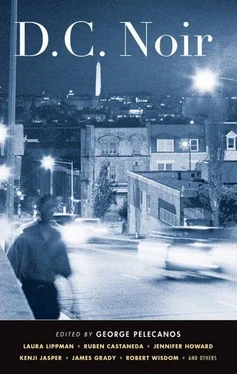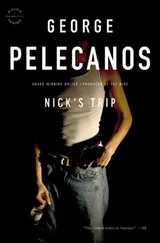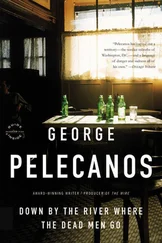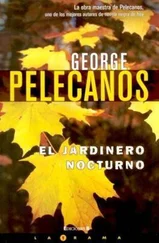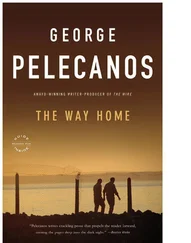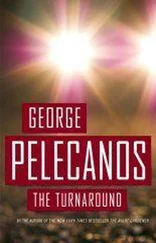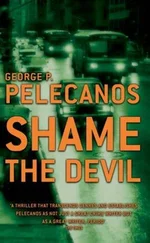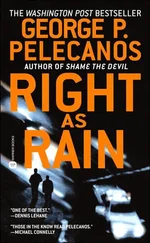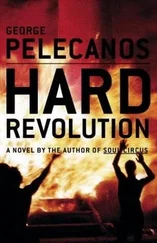Cort suppressed a chuckle. Driving over, he’d tuned in to an all-news station. A radio reporter had breathlessly noted that the violence erupted on the Mexican holiday Cinco de Mayo, and speculated on a connection. Mount Pleasant was Salvadoran territory, with Hondurans, Guatemalans, and Nicaraguans mixed in.
Cort said, “Yeah, bad information. Thanks, Father. I’ve got to roam now.”
“Good to see you, Cortez. Drop by anytime. You’re always welcome at Mass.”
Cort stepped away, surveying the aftermath of the bedlam. His stomach churned as the dimensions of the missed opportunity sunk in.
“Goddamnit.”
Even with the city clocking nearly 500 murders a year, Cort had to hustle for a byline. For every ten murders, one would yield a story, usually a fifteen-inch quickie buried inside Metro.
A yuppie victim was guaranteed decent ink. But a black or Hispanic homey gunned down in the hood? Well, that’s what the Briefs column was for.
Cort reached the end of the riot zone, hooked a right, and ambled north on Mount Pleasant Street.
The street featured dollar stores, bars, greasy carryouts, liquor stores, old apartment buildings, and Heller’s Bakery, which arguably produced the finest cakes in the city.
The MacArthur Park section of Los Angeles was Little El Salvador, and Mount Pleasant was its East Coast counterpart. Inside Haydee’s, a Salvadoran restaurant, former Marxist guerillas drank beer with ex — Salvadoran Army soldiers as they argued over soccer games playing on a TV behind the bar. Nearby, Salvadoran day laborers stood outside 7-Eleven, or “ El Seven ,” as they called it, waiting for work. Salvadoran vendors with metal carts dotted the street, hawking fresh mangos.
To the west, a series of quiet, tree-lined residential streets with row houses sloped down toward Rock Creek Park and the National Zoo.
The street was unscathed, except for El Seven. A window had been shattered and a store worker swept glass off the sidewalk.
Cort pulled out the cell phone and punched in Chuck’s number. “Everything’s quiet now. I’m heading back.” He clicked off, muttering, “Goddamnit.”
He was three blocks from the office when a high-pitched screech rang out from the police scanner.
A woman dispatcher said, “ Attention units paged. Third District officers at a stabbing at an apartment building, the corner of Park Road and Mount Pleasant Street. Homicide requested.
Cort pulled over to the curb. Mount Pleasant Street dead-ended at Park Road, three blocks north of 7-Eleven, one block over from 16th Street.
A murder on the edge of the riot zone? Huh.
Cort pulled out the cell phone and called Chuck.
“Yeah, I heard it,” Cort said. “I’m heading back. Maybe it’s connected to the riot. I’ll call as soon as I know.”
The brick apartment building was four stories high, with a fading, chipped white paint job and a well-manicured lawn decorated with shrubs and small shade trees.
A concrete walkway stretched thirty yards from the side-walk to the glass double-doors at the front entrance. From the entrance, the building jutted out on both sides out to the sidewalk, in a half H configuration. A short, black iron fence surrounded it. Yellow crime scene tape was draped across the width of the fence.
The victim was halfway down the walkway, lying on his back, his head turned away from the street.
He was a stocky Hispanic man, in his early twenties, wearing faded blue jeans, a yellow polo shirt, and black canvas sneakers. The chest area of his shirt was stained a dark crimson. His right arm was crooked at an angle above his head, and his left arm was parallel to his body. Wooden crutches lay on either side of him.
Two crime scene technicians in navy-blue uniforms worked around the body. One leaned down and shot photos. The other, wearing disposable latex gloves and holding a flashlight in her left hand, was on her hands and knees, looking for evidence.
A uniformed sergeant Cort knew from previous shooting scenes stood just inside the front gate. An unmarked sedan and a squad car were parked in front of the building. The detective was probably inside the building, interviewing witnesses.
To the right, a handful of spectators had gathered on the sidewalk. A local TV newsman, Brad Bellinger, chatted them up while a cameraman rolled tape on the body.
Across the street, to the left, three young Latino men in jeans and battered sneakers stood underneath a streetlight in front of the Argyle convenience store. Two of the men looked anxious, they kept looking from the body to the third man and back again. The third man, slightly older, in his late twenties, leaned against the lamppost, his gaze steady on the body. He looked like he was doing a slow burn.
Cort soaked it all in as he walked deliberately toward the crime scene, his satchel slung over his right shoulder.
He stopped at the gate and asked the sergeant, “This related to the riot?”
“Unlikely.” The sergeant nodded over his shoulder, toward the body. “Victim has an MS-13 tat on his forearm, my money’s on a gang beef. The guy from Homicide’s inside, he’ll be out soon.” MS-13 was a Salvadoran gang.
“Thanks.”
Cort turned and sauntered toward the three Latinos. Maybe they’d seen something.
One man was wearing a white and red Budweiser T-shirt and a chain with a silver cross around his neck. The guy next to him wore a soccer shirt emblazoned with the light-blue and white Salvadoran flag. The older man wore a red Chicago Bulls T-shirt.
They clammed up when Cort got within earshot.
“Buenas noches,” Cort said.
Tentatively, the two younger men responded in kind. The older man gave Cort the once-over. In Spanish, he said, “Who are you?”
“Periodista,” Cort replied. In Spanish, Cort identified himself: “My name is Cortez DeLojero, I’m a reporter for the Washington Tribune.” He gestured toward the murder scene. Continuing in Spanish, he said, “Can you help me with what happened? Is this about the riot?” He kept his notebook and pen holstered; bringing them out too soon spooked some civilians.
The two younger men looked at their shoes.
The older man peered at Cort a long moment, then said, “This isn’t about the riot.”
Budweiser said, “His name was Roberto Arias. He deserved better.”
No riot angle. Probably a gang beef. He could hear Chuck say, dismissively, “Brief it.”
Cort put his palms out. “So, what happened?”
Chicago moved off the lamppost and squared up to Cort. “He was murdered by a coyote . He was behind in his payments, because he was hurt, and the son of a bitch killed him.”
Cort felt an adrenaline surge. This was interesting.
“How do you know?”
Chicago pointed to an apartment building adjacent to the murder scene. “The three of us live there, we share an apartment. Roberto lives, lived , next door, with his sister. We were walking home, Roberto was going to his place. He screamed. We ran over — Gato was standing over him. He pointed his knife at us and said, ‘This is what happens to people who don’t pay.’ Then he wrapped the knife in a bandana and ran that way.” Chicago pointed west, toward the neighborhood of row houses.
Halfway into the account, Cort had pulled out his note-book and pen, and was writing furiously. He jotted “Bud,” “Sal,” and “Chi,” respectively, next to each man’s statement.
“Did Roberto say anything?” Cort asked.
“He couldn’t. He gasped, and he was gone,” Chicago said.
A death scene — outstanding. Cort walked them through the evening.
Chicago said they’d been playing soccer at a nearby schoolyard. Roberto watched. When the game ended, the riot was raging. They went to a friend’s apartment and waited it out. They had a few beers and walked home after calm was restored.
Читать дальше
